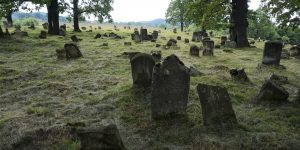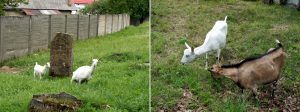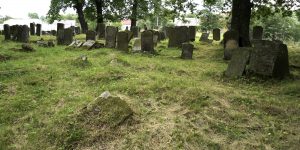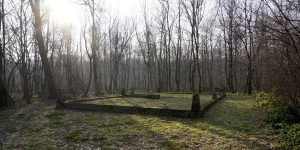![]() Ця сторінка також доступна українською.
Ця сторінка також доступна українською.
Introduction
This page summarizes and analyzes an ongoing project for the clearing and maintenance of wild vegetation in the Jewish cemetery of Bolekhiv in the Bolekhiv raion of the Ivano-Frankivsk oblast in western Ukraine, and at a Jewish wartime mass grave in a forest outside of Bolekhiv. The seasonal clearing and maintenance is performed by local people and managed by a Jewish descendants organization. The cemetery maintenance follows on a larger project to preserve and maintain the cemetery undertaken by the Jewish descendants organization in coordination with other organizations working at the same site and other sites in western Ukraine. In addition, other organizations have undertaken related projects at the cemetery as well as other cemeteries in western Ukraine. This page shares information with the related case study 15 active at the same sites.
This page is intended as a reference for similar projects now in the planning stages in western Ukraine or beyond. Following a brief summary of the site, the material below describes the project and reviews its effectiveness together with a listing of issues encountered, approximate project costs, and ongoing risks. Related projects both in western Ukraine and elsewhere in Europe are also briefly mentioned, for comparison. At the bottom of this page are links to project documentation and to additional reference information about the burial site and related projects.
Read the overview to case studies of selected projects at Jewish burial sites in western Ukraine.
Project Summary
Project type: Clearing of wild vegetation (heavy grass, woody shrubs and small trees, and dead tree branches) plus accumulated trash and debris at the cemetery and the mass grave.
Location and site type: Jewish cemetery of Bolekhiv, Bolekhiv raion, Ivano-Frankivsk oblast, Ukraine. GPS: 49.05736, 23.85710. Jewish wartime mass grave northwest of Bolekhiv, Bolekhiv raion, Ivano-Frankivsk oblast, Ukraine, in the forest between Bolekhiv and the village of Taniava. GPS: 49.08599, 23.82695.
Description of the site: The cemetery perimeter is an irregular shape of approximately 580m length, enclosing roughly 1.8 hectare of area, on a hilltop site with moderate slope. The mass grave extends to unknown dimensions on flat ground in a forest clearing approximately 175m from vul. Sichovykh Striltsiv, about 3.5km northwest of the town center. There are also several wartime mass graves located within the cemetery itself.
Ownership and stakeholders: Legal ownership of the cemetery site is unknown, presumed defaulted to the municipality of Bolekhiv. Ownership of the mass grave site is unknown, likely the municipality of Bolekhiv or the Dolyna raion administration. Stakeholders include the Bolechow Jewish Heritage Society, the cemetery neighbors and the local civil community, foreign descendants of Bolekhiv’s pre-war Jewish and other families, historians, and students of Jewish culture.
Official heritage status: Unknown.
Activists working on/at the site: Bolechow Jewish Heritage Society (BJHS), a registered US 501(c)(3) non-profit organization founded in 2007 and based in Bethesda, Maryland, US. Contact info. See also the BJHS Facebook page.
Other projects active at the site: Construction of a full perimeter fence (see BJHS cemetery project page); information and directional signage (see case study 15); digital documentation of the cemetery terrain (see ESJF 2019 survey project); partial digital photographic survey of headstone images (see CJA 2009 documentation page); full digital documentation with online searchable indexing of headstone images, inscriptions, and locations (see JGB cemetery documentation page and field school reports from 2013 and 2014); mass grave research and documentation at the cemetery site (see Yahad – In Unum 2013 research summary).
Project Analysis
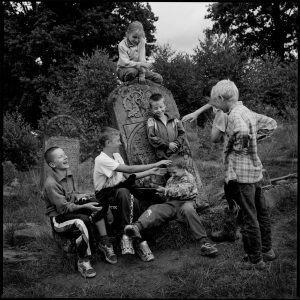
Children playing in the cemetery in 2001. Photo © Matt Mendelsohn.
History of the site: See case study 15 for history specific to the Taniava forest mass grave of Bolekhiv Jews.
In the Yizkor Book for Bolekhiv, Dr. M. Hendel reports that the Polish landowner of the original village aimed to create a new town of Bolekhiv, applying to the king for privileges for Jews to settle in the area and to have equal rights to local gentiles. The king approved the request in 1603, and Jews were given a grant of land for a cemetery and a shul. Surveys of all matzevot in the cemetery by Jewish Galicia and Bukovina (JGB) in 2013 and 2014 revealed that the oldest burial dates still recorded there in stone are 1615 and 1685, with more than 60 stones surviving from the 1700s. In the Yizkor book, the cemetery is mentioned only once more in stories of Jewish life in Bolekhiv before the Holocaust, and then only obliquely. Two Yizkor book authors record mass killings at the Jewish cemetery in October 1941 and subsequent mass burials there through 1943 from other killing events at the cemetery and in town, as well as of Jews who died in the ghetto from typhus and starvation; the western end of the cemetery is identified as the primary burial area for most of these victims. Two of the authors also mention significant damage to the cemetery during the German occupation, including the felling and removal of some of the headstones for construction works.
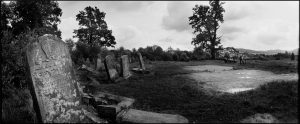
A view of the cemetery west end and mass grave area in 2001. Photo © Matt Mendelsohn.
The few surviving Jews of Bolekhiv left the region after WWII, and not many visited the town again in the 20th century. In 2001, four siblings of the Mendelsohn family of the US, Jewish descendants of the Jaeger family of pre-war Bolekhiv, traveled to the town to research their roots. One sibling created a section on his family website about the visit; another has documented images of the town and the Jewish cemetery on his professional photography website; a third wrote a critically-acclaimed and best-selling non-fiction book about his family research and the relatives who disappeared in the Holocaust in Bolekhiv.
The non-profit Bolechow Jewish Heritage Society (BJHS) was formed in 2007 by Jewish descendants and interested others with the aim of protecting and commemorating the cemetery and other Jewish heritage sites in Bolekhiv. A survey of the cemetery site by the Heritage Foundation for Preservation of Jewish Cemeteries (HFPJC) – Avoyseinu preceded the reconstruction by BJHS and HFPJC of a full-perimeter wall around the cemetery in 2009, and other cemetery maintenance activities as part of this project.
Also from 2009, several Jewish heritage organizations have documented the cemetery in various ways, including through photographs and the transcription/translation of headstone epitaphs, as well as perimeter and terrain surveys. The Jewish Galicia and Bukovina group, with the support of BJHS, conducted a comprehensive photographing of the cemetery tombstones, searchable by an online index.
Current features of/at the site: See case study 15 for a description of the forest mass grave site. The cemetery is situated adjacent to a small road about 1km south of the town center of Bolekhiv. The road bounds a portion of the south perimeter of the cemetery, with agricultural and grazing fields wrapping the entire west end of the site; residential houses and gardens abut against the cemetery on the north and short east sides. The cemetery is enclosed by a steel-reinforced poured concrete wall built by BJHS and HFPJC to about 2m high, without openings except for a wide steel gate in the north section of the wall. Access to the site is complicated by private property boundary walls which close off a former public road to the cemetery gate; access is currently via a neighbor’s garden (the neighbor’s phone number is on a sign on Olena Pchilka Street outside a gate to his property). An information sign in three languages is placed prominently adjacent to the cemetery gate (see case study 15). Surveys of standing headstones in the cemetery have counted nearly 1500 surviving matzevot, many in very good condition despite their considerable age. The graves of three prominent rabbis are marked with memorial markers and painted concrete surrounds. The grounds are currently covered with well-maintained grasses; about a third of the site is covered by a canopy of very tall oak trees.
Details of the project: A first complete clearing of dead and wild vegetation at both the cemetery and mass grave sites was organized and paid for by BJHS members in Israel and the US ahead of a planned commemorative ceremony in Bolekhiv in 2009. At that time, grandchildren of a Ukrainian Christian family, which had sheltered two Jewish brothers at their home in Bolekhiv during the deadly German occupation of World War II, agreed to do the clearing work for a modest fee. The BJHS purchased tools and equipment to support the initial clearing work, and the local family worked together to complete the task. At the time of the ceremony, leaders of the BJHS met with the local family and proposed a long-term arrangement to pay for clearing work at both sites three times per year during the growing season, and remove heavy grass and shrubs on the ground plus any dead and fallen tree branches; the local family agreed, and has continued the clearing work each year since.
Issues encountered in the project: None. The project is proceeding smoothly, now for roughly a decade.
Project costs, one-time and sustaining: The purchase cost for tools and equipment was typical for western Ukraine, which closely matches that of western Europe and the US for similar-quality tools; normal tool wear means that most tools require replacement after 5 to 10 years of careful use and maintenance. Labor costs for this project have been lower per hectare of area than the project documented in case study 05, largely because the physical work is directly and efficiently managed by the local family with close personal connections to Jewish survivors from Bolekhiv.
Current risks to preservation: In western Ukraine, vegetation grows rapidly throughout the warm months of the year, which requires regular monitoring and action to prevent overgrowth and damage to the sites; the arrangement between the BJHS and the local family ensures the sites are appropriately cared for. The large oak trees on the cemetery grounds will naturally shed heavy branches from time to time, and more during severe weather events, possibly causing damage to a small number of standing matzevot if the limbs are not carefully cut and removed before they weaken and fall; the grounds around the mass grave memorial have been cleared of trees, eliminating this risk. As for many open areas without buildings in western Ukraine, nearby residents may occasionally use the sites for grazing animals such as goats, but this rarely damages cemeteries, and the practice is diminishing in Ukraine as small farming recedes from towns and cities. No other risks are apparent, apart from ordinary weathering of the headstones.
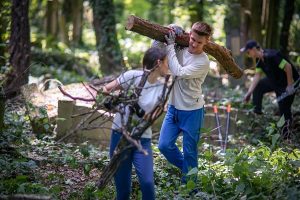
TMF volunteers working in the Częstochowa Jewish cemetery in 2019. Photo © TMF.
Related projects in western Ukraine: Rohatyn Jewish Heritage (RJH) manages volunteer vegetation clearing projects with manual and machine cutters at the Jewish burial sites in Rohatyn (Ivano-Frankivsk oblast; see case study 05), and has worked with the Lviv Volunteer Center at other sites such as Kalush (Ivano-Frankivsk oblast). ESJF European Jewish Cemeteries Initiative manages cemetery fencing projects in western Ukraine and elsewhere; some projects such as Kuzmino (Zakarpattia oblast) include clearing as an integral step.
Related projects outside western Ukraine: In Poland, the US Christian non-profit charity organization The Matzevah Foundation (TMF) conducts annual volunteer events clearing Jewish cemeteries, at typically 5 to 10 locations; in 2019, they continued work in Częstochowa, Krośniewice, Krzepice, Oświęcim, and Przerośl. TMF also provided hands-on training to RJH during volunteer events in Nasielsk, Poland and in Rohatyn. Filtered searches of news articles on the web portal Jewish Heritage Europe return many clearing project reports at Jewish cemeteries around Europe; among those are projects at the Kozma street cemetery in Budapest, Hungary, at Beshenkovichi, Belarus, and at Tuzla, Bosnia and Herzegovina.
References
- Cemetery Restoration/Preservation – cemetery project summary page with a photo slideshow, a catalog of documented matzevot, and headstone transcription guides, by the Bolechow Jewish Heritage Society (BJHS)
- History of Bolechow – links to Bolekhiv maps and other family and general history research aids by the Bolechow Jewish Heritage Society (BJHS); see also the Wikipedia page on the Holocaust in Bolekhiv
- Memorial book of the martyrs of Bolechow (Bolekhiv, Bolechów), Ukraine – an online English translation of Sefer ha-zikaron le-kedoshei Bolechow, the Yizkor (memory) book for Bolekhiv’s pre-war Jewish community, coordinated by Alex Sharon, hosted by JewishGen on the website for their Yizkor Book Project; see also an online image set of the original Hebrew and Yiddish version of the book, as “Bolekhiv”, hosted by the New York Public Library Digital Collections
- In the Footsteps of the Lost – photo essay on travel to Bolekhiv and related places, including images of the Jewish cemetery in 2001, by Matt Mendelsohn
- Bolekhiv Jewish Cemetery – terrain measurements and survey notes from 2019 by ESJF European Jewish Cemeteries Initiative
- Bolechow cemetery – the 2014 cemetery documentation project page on the Jewish Galicia and Bukovina website
- Bolechów Cadastral Map 1850/1878 – a highly detailed historical property map of the town from a survey during the Austrian era, showing the Jewish cemetery and many other town features, from map panels preserved by the Central State Historical Archive in Lviv (TsDIAL) and presented by Gesher Galicia
- Bolekhiv – the killing sites and mass graves survey page, including the site at the Bolekhiv Jewish cemetery, on the Holocaust by Bullets web map of Yahad – In Unum
- Jewish Cemetery in Bolekhiv (Bolechów) – cemetery survey page with photos from 2009 by the Center for Jewish Art
- On Galician Roads Again – a photo and text essay from 2017 covering the Bolekhiv Jewish cemetery and cemeteries between Lviv and Ivano-Frankivsk, from Christian Herrmann’s Vanished World blog site

